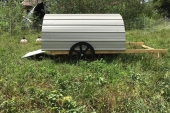





S. Bard wrote:Thanks AJ and John for your input!
How many goats could be put on this land without risk of overgrazing and how would you go about it? Divide the land into two or more strips so the goats can be rotated? Just use it as a single pasture? What trees/ shrubs should I consider planting? What kind of fencing would you suggest that could work both for goats as chickens/geese?
Thanks!


Anne Pratt wrote:
I’m a little extra sensitive to the predator question. Since March we had a bear tear the door off the coop at night (got one of my four) and a coyote or fox take one from the edge of the woods in the daytime. With only two left we just got two more. And the coop has mega bolts on everything and we installed a long 2” x 4” bar across the door that goes in every night. Never had a predator all the first year. Mine free range in the daytime and (1) they love it and (2) they eat all the ticks. We aren’t willing to change that.

Anne Pratt wrote:I spent some time trying to figure out how critters would pull off their heads. I guess that the wire on the bottom is 1" X 1"? I think conventional wisdom is that half-inch, heavy gauge hardware cloth will protect them from almost anything, but I wouldn't use 1" x 1".
Heat is another interesting question. Insulating the ceiling seems pretty difficult and awkward. I would vote for shade, but then what's the point of a mobile coop if you have to move it to the shade?
But I love the design! It looks quite nice, seems like the hens would be comfortable, and could be weatherized a bit more for our cold winters (it just needs windbreak on the ends, I think). What are the dimensions?
Those bars across the floor are for the girls to roost on? Mine prefer to be elevated (instinct tells them it's safer). That would also be a big improvement in my book.
Nice coop!

S Bengi wrote:A total price of $600 with 1/3 of that for your labor/profit and the other $400 aka 2/3 for the cost of material, sounds very reasonable.
I wonder how hot it gets.
I wonder how easy it is for critters to rip off there heads from inside the coop at night.